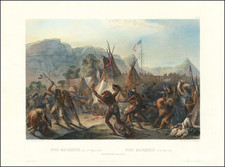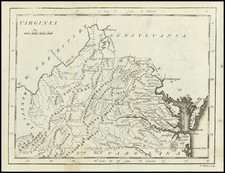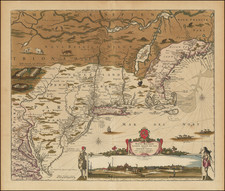Idolum Kiwasa XXI, engraved by Theodor De Bry and published in Frankfurt in 1591, depicts the Kiwasa idol of Secota, associated with overseeing the dead in its temple. This is an original engraving from De Bry's Grands Voyages series.
The text provides a detailed account of the indigenous religious idol Kiwasa, the ritual practices associated with it, and the European interpretation of these practices during the 16th century. Positioned in Secota's temple, the idol underscores its role in local customs, especially in relation to the deceased. The description also alludes to the residents' limited exposure to external religious practices, yet indicates their observational inclinations. Such illustrations provide insights into the era's cultural intersections, revealing nuances of early interactions and shared human curiosity.
The text translates as follows:
"The inhabitants of this region have an idol called Kiwasa, crafted from a wooden trunk, four feet high, with a head resembling that of the inhabitants of Florida: the face is painted flesh-colored, the chest white, and the rest of the body black, with legs also variegated with white paint. From its neck hang necklaces made of white beads, interspersed with other round, hollow beads, more esteemed by them than gold or silver. This idol is placed in the temple of the town SECOTA, positioned as though guarding the corpses of the rulers. Sometimes there are two such idols in the temples, occasionally three, but never more; and because they are placed in a dimly lit spot, they have a dreadful appearance. These poor people have no other knowledge of God, although they seem very desirous of such knowledge: for when we knelt down to pray to God, they imitated us, and noticing us move our lips, they did the same; hence, it is probable that they could be easily led to the knowledge of the Gospel. May God grant them this grace."
During the late 16th century, European explorers were documenting their encounters with previously unknown regions and their inhabitants. Theodor De Bry's Grands Voyages sought to compile these accounts. The Kiwasa idol, as portrayed, stands at approximately four feet, carved from wood. Its features, especially the head, seem reminiscent of the Florida natives. According to the text, the idol's contrasting color scheme—flesh-toned face, white chest, and black body—is complemented by torques made of white beads interspersed with sand beads, illustrating local artistic and material preferences.
Positioned in Secota's temple, the idol underscores its role in local customs, especially in relation to the deceased. The description also alludes to the residents' limited exposure to external religious practices, yet indicates their observational inclinations. Such illustrations provide insights into the era's cultural intersections, revealing nuances of early interactions and shared human curiosity.
Theodor de Bry (1528-1598) was a prominent Flemish engraver and publisher best known for his engravings of the New World. Born in Liege, de Bry hailed from the portion of Flanders then controlled by Spain. The de Brys were a family of jewelers and engravers, and young Theodor was trained in those artisanal trades.
As a Lutheran, however, his life and livelihood were threatened when the Spanish Inquisition cracked down on non-Catholics. De Bry was banished and his goods seized in 1570. He fled to Strasbourg, where he studied under the Huguenot engraver Etienne Delaune. He also traveled to Antwerp, London, and Frankfurt, where he settled with his family.
In 1590, de Bry began to publish his Les Grands Voyages, which would eventually stretch to thirty volumes released by de Bry and his two sons. The volumes contained not only important engraved images of the New World, the first many had seen of the geographic novelties, but also several important maps. He also published a collection focused on India Orientalis. Les Grands Voyages was published in German, Latin, French, and English, extending de Bry’s fame and his view of the New World.









![[ Native American about to Murder A Frenchman in a Dugout Canoe ] Petri Gambie Galli Caedes](https://storage.googleapis.com/raremaps/img/small/97871.jpg)

![[Jefferson's Notes on the State of Virginia] Observations sur la Virginie [with the map:] A Map of the country between Albemarle Sound, and Lake Erie, comprehending the whole of Virginia, Maryland, Delaware, and Pensylvania, with parts of several other of the United States of America. Engraved for the Notes on Virginia.](https://storage.googleapis.com/raremaps/img/small/51828.jpg)
![[ 20 Historical Border Survey Maps Tracking The History of Pennsylvania's Borders ]](https://storage.googleapis.com/raremaps/img/small/96836.jpg)

